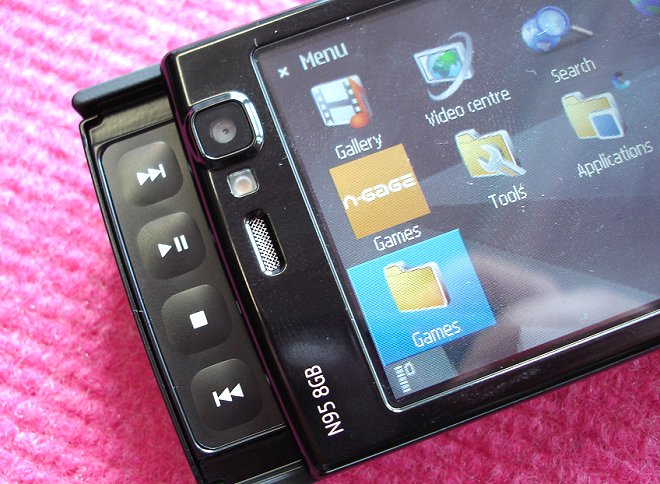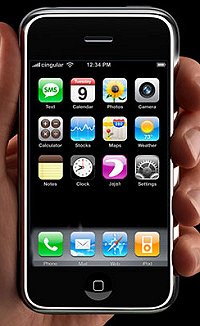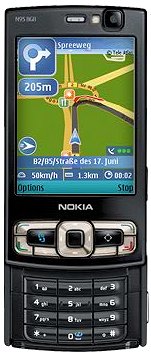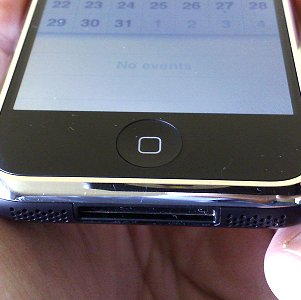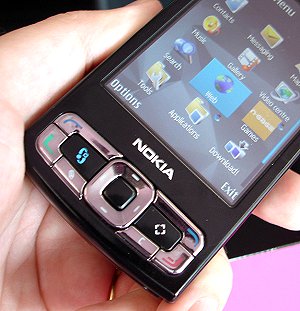The original N95/iPhone battle may have moved onto new stomping grounds, but it's still a battle royal. Between strength and subtlety, between functions and form, between features and ease of use. Both devices are either aimed at totally different markets or aimed at the same market, depending on who you talk to. But the fact remains that the Nokia N95 8GB and Apple iPhone are the two most desirable smart devices anyone will be able to own this Christmas.
Let's put them head to head and try to be totally objective:
Apple iPhone | Nokia N95 8GB | |
|
| |
| Form factor | Glass-topped tablet, 3.5" touchscreen, reasonable outdoor contrast, four physical buttons/switches | Fairly robust slider phone, 2.8" screen, reasonable outdoor contrast, 25 buttons, including traditional phone keypad |
| Typical price on a £35 a month contract with 'unlimited' data | £270 (minimum contract with O2 = 18 months, total cost of ownership over period is £900) | £38 (on an 18 month contract with Vodafone, total cost of ownership is £668) |
| Runs | Version of Apple's desktop OS X | S60 3rd Edition, Feature Pack 1, on Symbian OS. |
| Battery life | Good, but integral, non-removable battery, 1230mAh. | Good-ish, BL-6F battery can be removed and replaced quickly, 1200mAh. |
| Connectivity | EDGE, if available, otherwise GPRS. Plus Wi-Fi, also where available. | GPRS, EDGE, plus high speed 3G, and ultra-high speed HSDPA, plus Wi-Fi where available. |
| Performance and RAM | Full multitasking, but hidden from user, with all applications selected from home screen. Pretty quick. Exact RAM details unknown. | Pretty quick, and around 90MB of free RAM after booting, thanks to a demand paged version of Symbian OS, with full multitasking. |
| Built-in Applications | A restricted application set, but graphical and hyper-intuitive. | The usual S60 glut of apps and mini-apps, with something of a media/online bent. |
| Web browsing | A good touch-driven experience (rather limited by EDGE bandwidth though) using Safari. No Flash or Java support at all though. | A similarly good experience, this time limited by screen real estate and not bandwidth, with very similar browser code (both based on the same open source Web modules). Flash and Java support, though not yet working with Flash video. |
| Text entry | Text entry via fingers using an on-screen keyboard. Word prediction software helps to enlarge screen touch-sensitive hotspots for likely followup letters, improving typing accuracy a lot. No option for Bluetooth keyboard, at present, sadly. | With no touchscreen or keyboard, text entry is relatively inconvenient, using predictive text on the keypad, and mostly impossible when the N95 8GB is in 'landscape' mode (although a separate Bluetooth keyboard gets round this fairly easily) |
| Imaging/Video | Acceptable (for casual snaps) 2MP camera, fixed focus, no flash, no video recording. | Awesome 5MP camera with professional lens, auto-focus, multiple scene modes and settings, bright flash, VGA video recording at up to 30 fps. |
| Music and expansion | Very slick, as you'd expect, and with browsable cover art, MP3 and AAC formats supported. 8GB flash memory capacity, non-expandable. | Very slick, with dedicated hardware controls, although cover art is often hit and miss, depending on your music source. MP3, AAC and WMA formats supported. 8GB flash memory capacity, non-expandable. A2DP also supported, for wireless listening. |
|
| |
| Durability | Pouched/cased by necessity, to protect the touch-screen from damage. | Pretty durable, with a hard plastic covering over the screen. The camera is not mechanically protected (as on the original N95) but it's recessed and not too vulnerable. |
| Real world experience | In use, requires two hands to use most of the time. | Almost all operations are easy to accomplish one-handed. |
| Office work | Word/Excel/PDF viewers built into the email client. No editing options, although workarounds using Ajax applications on web sites are possible. | Quickoffice 3.8 viewers (upgradable to v4.5 round-trip-perfect editing), plus Adobe Reader LE 1.5. |
| Navigation | Native version of Google Maps, but no GPS support. | Built in GPS (assisted via data connection), native Nokia Maps with ad-hoc upgrades for voice guided navigation. Google Maps is free and a native GPS-aware S60 application, as an alternative. |
| Extra applications | Officially extensible using Widgets and Web applications in the Safari web browser - there's an active unlocking and hacking community, but Apple keeps raising the bar and locking third party native applications out. | Around 800 native S60 applications and games, plus thousands more Java apps/games and Widgets. Python, Ruby and Flash Lite applications are also supported. |
| Extra connectivity | Recessed 3.5mm headphone socket (only works with Apple headset and TV out accessory) | Standard 3.5mm headphone socket, also with integrated TV-out facility (sending screen feed or full res photos or videos to any TV or video equipment). |
| Desktop integration | Seamless integration with iTunes on Mac or Windows desktops | Full functioned but messy integration with PC Suite and other tools on PC, Nokia Multimedia Transfer, iCal/iSync on Mac, etc. |
Apple iPhone | Nokia N95 8GB |
Looking at the table above, it's clear that the iPhone is rather seriously outgunned by the N95 8GB, but there are wins for the high profile device from Apple. It's cleaner, more elegant, has a larger screen, great text input method and more foolproof desktop connectivity. And that shortlist of wins is probably enough for a lot of purchasers, especially those with lesser ambitions and sufficiently deep pockets.
But the Nokia N95 8GB is simply awesome as a piece of technology, winning by a landslide on data connectivity, camera, video camera, GPS and application openness. Paired with a Bluetooth keyboard, the N95 8GB can, for short periods, replace phone, camera, camcorder, music player, navigation device, laptop, games console and Blackberry, among others. And, unlike the original N95, it can do all this without worrying too much about battery life or at all about running out of RAM.
Steve Litchfield, 28 October 2007
